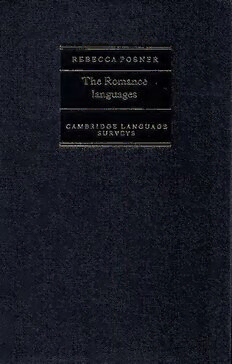
The Romance Languages PDF
Preview The Romance Languages
What is a Romance language? How is one Romance language related to others? How did they all evolve? And what can they tell us about language in general? In this comprehensive survey Rebecca Posner, a distinguished Romance specialist, examines this group of languages from a wide variety of perspectives. Her analysis combines philolog¬ ical expertise with insights drawn from modern theoretical linguistics, both synchronic and diachronic. She relates linguistic features to his¬ torical and sociological factors, and teases out those elements which can be attributed to divergence from a common source and those which indicate convergence towards a common aim. Her discussion is extensively illustrated with new and original data, and an up-to-date and comprehensive bibliography is included. This volume will be an invaluable and authoritative guide for students and specialists alike. THE ROMANCE LANGUAGES Cambridge Language Surveys General editors: B. Comrie, C. Ewen, R. Huddleston, R. Lass, D. Lightfoot, J. Lyons, P.H. Matthews, R. Posner, S. Romaine, N.V. Smith, N. Vincent This series offers general accounts of all the major language families of the world. Some volumes are organised on a purely genetic basis, others on a geographical basis, whichever yields the most convenient and intelligible grouping in each case. Sometimes, as with the Australian volume, the two in any case coincide. Each volume compares and contrasts the typological features of the languages it deals with. It also treats the relevant genetic relation¬ ships, historical development and sociolinguistic issues arising from their role and use in the world today. The intended readership is the student of linguistics or general linguist, but no special knowledge of the languages under consideration is assumed. Some volumes also have a wider appeal, like that on Australia, where the future of the languages and their speakers raises important social and political issues. Already published: The languages of Australia R. M. W. Dixon The languages of the Soviet Union Bernard Comrie The Mesoamerican Indian languages Jorge A. Suarez The Papuan languages of New Guinea William A. Foley Chinese Jerry Norman Languages of Japan M. Shibatani Pidgins and Creoles (Volume I: Theory and structure; Volume II; Reference survey) John H. Holm The Indo-Aryan languages Colin Masica Forthcoming titles include: Korean Ho-Min Sohn The languages of South-East Asia J.A. Matisoff The Austronesian languages R. Blust The Slavonic languages R. Sussex The Germanic languages R. Lass THE ROMANCE LANGUAGES REBECCA POSNER University of Oxford Cambridge UNIVERSITY PRESS Published by the Press Syndicate of the University of Cambridge The Pitt Building, Trumpington Street, Cambridge CB2 1RP 40 West 20th Street, New York, NY 10011-4211, USA 10 Stamford Road, Oakleigh, Melbourne 3166, Australia © Cambridge University Press 1996 First published 1996 Printed in Great Britain at the University Press, Cambridge A catalogue record for this book is available from the British Library Library of Congress cataloguing in publication data Posner, Rebecca. The Romance Languages / Rebecca Posner. p. cm. - (Cambridge Language Surveys) Includes bibliographical references and index. ISBN 0 521 23654 1 (hardcover). - ISBN 0 521 28139 3 (paperback) 1. Romance languages. 1. Title. 11. Series. PC43.P595 1996 440-dc20 95-42167 CIP ISBN 0 521 23654 1 ISBN 0 521 28139 3 TAG CONTENTS Preface page xi List of language names xv List of abbreviations xvii Maps xviii INTRODUCTION Why the Romance languages? 1 What do Romanists worry about? 7 What do Romanists argue about? 10 What contribution can Romance studies make to synchronic and diachronic linguistics? 11 Conclusion 30 Further reading 30 PART I THE SIMILARITIES 1 What is a Romance language? Part 1 1.1 What is a Romance language? 35 1.2 Person markers 39 1.3 Noun gender 55 1.4 In place of a partial conclusion 69 Further reading 70 2 What is a Romance language? Part 2 2.1 Romance‘family’and Romance‘type’ 71 2.2 Romance functional morphemes 71 2.3 Word formation 80 2.4 Shared lexicon 87 vii viii Contents 2.5 Loanwords 93 2.6 How close are Romance lexieons? 94 2.7 Romanceness as a continuum? 94 Further reading 96 3 Latin and Romance 3.1 Derivation 97 3.2 Proto-Romance or Vulgar Latin 98 3.3 Differences between Latin and Romance 104 3.4 Latin influence 139 3.5 Who killed Latin? 152 Further reading 154 4 Convergence, interinfluence and parallel development 4.1 Drift and metarules 155 4.2 Diphthongization 157 4.3 The infinitive 163 4.4 Object clitics 167 4.5 Periphrastic aspectual forms 175 4.6 The future 177 4.7 The passive 179 4.8 Lexicon 181 4.9 Conclusion 184 Further reading 186 PART II THE DIFFERENCES 5 How many Romance languages? 5.1 How many Romance languages are there? 189 5.2 Genetic classification 196 5.3 Typology 200 5.4 Dialectometry 202 5.5 Standardology 206 5.6 Language and dialect 217 5.7 Creole and dialect 219 5.8 Creolization as creation, or as catastrophic change? 224 5.9 Conclusion 225 Further reading 226
